|
My machine tools
This is an overview of my machine tools to consider my production capabilities. The machines are not for sale.
 Tool-milling machine Heckert FUW-315/5 CNC Tool-milling machine Heckert FUW-315/5 CNC |
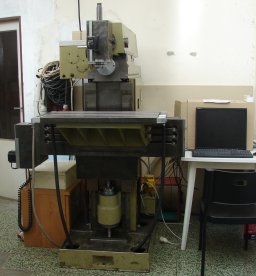
|
 |
|
Face-lifted 3-axis CNC milling machine, built 1984 in GDR. The machine was completely taken into parts,
cleaned and precisely adjusted, all the motors were replaced by brushless ones, and the whole
wiring, electronics and control was replaced by brand new elements and software.
The main benefit of this machine is the possibility of using two spindles - vertical and horizontal one,
which allows me to face-mill the ends of long pieces, or even use both spindles simultaneously,
so I can machine two perpendicular faces without reclamping the piece. In contrast to most of
new machines, this one is still equipped with a swivelling vertical head, so I can mill any slopings
without having to reclamp the part to the desired angle. Up to that, the vertical spindle is mounted
on an independent extensible beam, so I can reach an extreme spindle-setout (up to 90 cm), allowing me
to drill or machine the holes inside a large plate. The Y-travel is achieved by moving the spindle, not
the table, so the workpiece is always perfectly accessible. Quick and comfortable clamping of the workpiece
is also allowed by large table setup area with 8 T-slots. Of course the spindle allows for continuous
speed control using the frequency inverter, but in addition there is a two-speed electromagnetic gearbox,
so I can get a high torque at low RPM even with an economy-sized spindle motor.
|
| Technical data |
| Travels X×Y×Z | 520×400×350 mm |
| Table area | 700×400 mm |
| Spindle tapers | 2 × ISO 40 |
| Spindle RPM | 0-1500 RPM |
| Spindle power | 1.5 kW |
| Axes driven by | 3ph-stepper motors 6.8 Nm |
| Maximum feed rate | 900 mm/min |
| Positioning accuracy | 0.01 mm |
| Control system | SpaceCNC |
|
 Vrtačko-frézka KVF-520 CNC Vrtačko-frézka KVF-520 CNC |
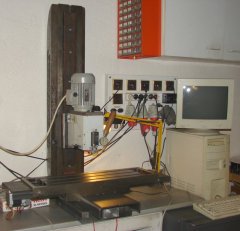
|
 |
|
This DIY CNC machine joins the advantages of a CNC milling machine and a manual drill press.
During a single-piece production, it would be very time-consumpting to prepare drilling and
threading cycles. A couple of holes are much easier to be drilled by hand, feeling the cutting
resistance of the material. I can interrupt the drilling or use a lubricant immediately, when
the chips begin to stuck in the hole. As soon as the drilling cycle is examined, the Z-axis
can be switched to CNC-control and the machine can start working unattended. The setup and working
area of this machine is competitive to a lot of bigger machines, particularly the spindle-head
elevation is high because of tall and massive column. That allows for milling and drilling even
very tall pieces. The spindle is powered using a 2-speed gearbox, allowing to achieve high torque
for tools with greater diameter or high speed for smaller tools, both with an economy-sized
motor. Of course there is a frequency inverter to smoothly tune the exact RPM.
|
| Technical data |
| Travels X×Y×Z | 520×280×150 mm |
| Rough Z-travel (manual) | 650 mm |
| Table area | 730×210 mm |
| Spindle taper | MT3 |
| Spindle RPM | 0-6.000 RPM |
| Spindle power | 1.1 kW |
| Axes driven by | 2ph-stepper motors 4 Nm |
| Rapid feed | 12 m/min |
| Positioning accuracy | 0.01 mm |
| Control system | SpaceCNC |
|
 Optimum D 320×920 lathe Optimum D 320×920 lathe |
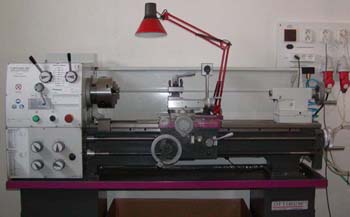
|
 |
|
Modern full-value universal lathe with unique utility properties and high accuracy.
Wide range of RPM, longitudial and transversal machine feed, taper and thread cutting.
Additionaly, the machine is equipped with end-switches, extending it to an semiautomatic.
While the lathe works, I can operate another machine without taking care when
the machine feed should stop.
Recently, the lathe was equipped with a frequency inverter and a digital revolution indicator,
which allows me to choose the optimal RPM even while the machine is running. That's
especially helpful during the face turning, when it is good to keep the constant cutting speed
by increasing the RPM.
Besides the lots of different tools, I've got also different types and sizes of chucks,
allowing to clamp almost any workpiece.
|
| Technical data |
| Turning diameter | 320 mm |
| Turning length | 920 mm |
| Spindle | Camlock D1-4" |
| Spindle bore | 38 mm |
| Motor rating | 1.5 kW |
| RPM range | 0-3200/min |
| Thread pitch | 0.15-26 mm |
| Tailstock taper | MT 3 |
|
 Asist 210×400 CNC lathe Asist 210×400 CNC lathe |
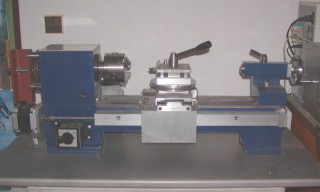
|
 |
This CNC mini-lathe is based on a common hobby lathe, that can be bought at any hobby market.
Only the bed, spindle, support and tailstock are utilized. The original motor and belt-gearbox
was replaced by a stronger one with a fixed V-belt drive, the spindle speed is controlled
by a frequency inverter. The spindle is equipped with a blocking latch, allowing for comfortable
tightening of pieces machined on an arbor. The trapezoidal screws are replaced with ball screws,
the tool holder is brand new and allows for repeated precise tool locating. The axes are powered
by strong stepper motors, the control electronics was purchased at
http://www.cncshop.cz.
The machine is controlled by a common desktop PC, running my own software. The programming includes
both low-level mode, allowing to control every single move, and high-level mode, when the tool
follows the trajectory prepared in DXF file. The goal is to have an optimal program for any operation.
I use the CNC lathe for single-piece production of complex-shaped parts, or for batch production of
both simple and complex parts, including all threads.
When using automatic collet chuck, air-powered pincers for grabbing and feeding the material,
and a guideway for 3-meter material (diamater up to 16 mm), the machine can be extended to an automatic lathe, producing
thousands of simple turned parts - see the video:
|
| Technical data |
| Turning diameter | 210 mm |
| Turning length | 400 mm |
| Chuck | ø100 mm |
| Spindle bore | 18 mm |
| Motor rating | 750 W |
| RPM | 20-2000/min |
| Tailstock taper | MT 2 |
| Stepper motors | Z=4 Nm, X=2.5 Nm |
| Feed speed | 0 - 6 m/min |
| Tool size | up to 12×12 mm |
|
 TOS SUF-16 lathe TOS SUF-16 lathe |
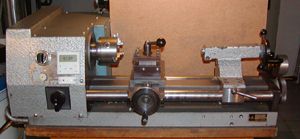
|
 |
I use this small and simple lathe for finishing operations (for example chamfering the edges)
or for making some small parts. Using both lathes together brings surprisingly effective work.
Having a second machine can also be useful when the first one is occupied by an important work
and you suddenly need to make some tiny or helper part.
In comparison to the original version, the belt-gearbox is replaced by a single V-belt and a frequency inverter.
|
| Technical data |
| Turning diameter | 160 mm |
| Turning length | 300 mm |
| Chuck | ø80 mm |
| Spindle bore | 14 mm |
| Motor rating | 550 W |
| RPM | 10-1750/min |
| Tailstock taper | MT 2 |
|
 TOS FH 32 horizontal milling machine TOS FH 32 horizontal milling machine |

|
 |
I use this machine for big material removals, rough work, machining of larger pieces,
steel milling, formating plates, longitudial material cutting, and also as
a powerful and precise boring and drilling machine.
Despite of the year of manufacture (1947) it is still a very precise machine.
All three axes are equipped with a machine-feed and rapid feed.
The main modifications to the original machine are: removing the driving slot
from the spindle (Morse drills and non-circular tools were impossible to use),
replacing the main motor, removing the belt drive and placing the motor directly
to the gearbox, and variable motor speed by frequency inverter.
|
| Technical data |
| Spindle taper | MT 4 |
| Motor rating | 2.2 kW |
| RPM range | 0-1400/min |
| Travels X×Y×Z | 630 × 230 × 480 mm |
|
 Optimum BF 20 Vario milling/drilling machine Optimum BF 20 Vario milling/drilling machine |
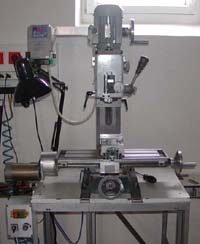
|
 |
Very handy, small machine, that can perform a really precise professional work
and also copes with quite a big material removal. I use this machine mostly as
a coordinate boring machine, allowing me to completely leave the scribe awl -
centre punch - drill press method. In contrast to the serial version,
this machine is equipped with a three-phase motor and frequency inverter, variable speed
longitudial machine feed, and a mechanical depth stop.
|
| Technical data |
| Spindle taper | MT 2 |
| Motor rating | 550 W |
| RPM range | 10-2600/min |
| Table travels | 320×170 mm |
| Drilling travel | up to 50 mm |
|
 Bomar Ergonomic 275.230 DG band saw Bomar Ergonomic 275.230 DG band saw |
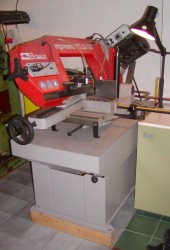
|
 |
|
The greater band saw is suitable for cutting full material with bigger cross section,
where the smaller band saw is not sufficient, or the operation takes too much time.
The main advantage is the automatic free-falling cutting feed and the terminal-switch,
basically allowing the autonomous operation. The saw can work without my attention,
while I'm handling any other machine. The safe and unmanned operation is supported
by the cooling system, serving rather as lubrication when cutting aluminium alloys.
In comparison with the smaller saw, this machine offers much more space for different
special operations, for example flat-cutting of larger plates, or cutting very short
pieces of material, that must be clamped using an intermediate machine vice, instead
of a direct clamp to the saw-vice. I also perform quite frequently the cut-off upon
the the piece clamped in a chuck, that is inserted in the saw-vice using a special holder.
With a little bit of invention, this band saw is also able to cut the dimensions
that considerably exceed the official cutting capacity of the machine.
|
| Technical data |
| Motor rating | 1.1 kW |
| Cutting speed | 80 m/min |
| Gravity cutting pressure | adjustable oil damping |
| Frame lifting | manual |
| Cutting capacity (vertical) | 230 mm |
| Cutting capacity (horizontal) | 330 mm |
| Angular cuts | -45º - +60º |
| Vice handling | setting: crank, clamping: lever |
|
 Bomar Pulldown 160.120 G band saw Bomar Pulldown 160.120 G band saw |
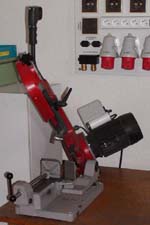
|
 |
I use this small bandsaw for cutting profiles and other material with small cross-section,
because it is much easier and quicker to operate. Sometimes I also need to cut something
while the bigger saw is busy by preparing another material, especially for mass production.
The advantages of a small bandsaw is lower material loss due to thinner saw band,
and lower operating cost, especially due to cheaper saw band. If a tooth breakes out,
or the saw band gets blunt, the cost is not so high.
For cutting full materials, the machine is equipped with a rotation brush for removing chips,
and with a still-power-on button for long-lasting cuts.
|
| Technical data |
| Motor rating | 370 W |
| Cutting speed | 80 m/min |
| Cutting capacity | 160×120 mm |
| Angle cuts | 0º-60º |
| Vice | quick-acting |
|
|













